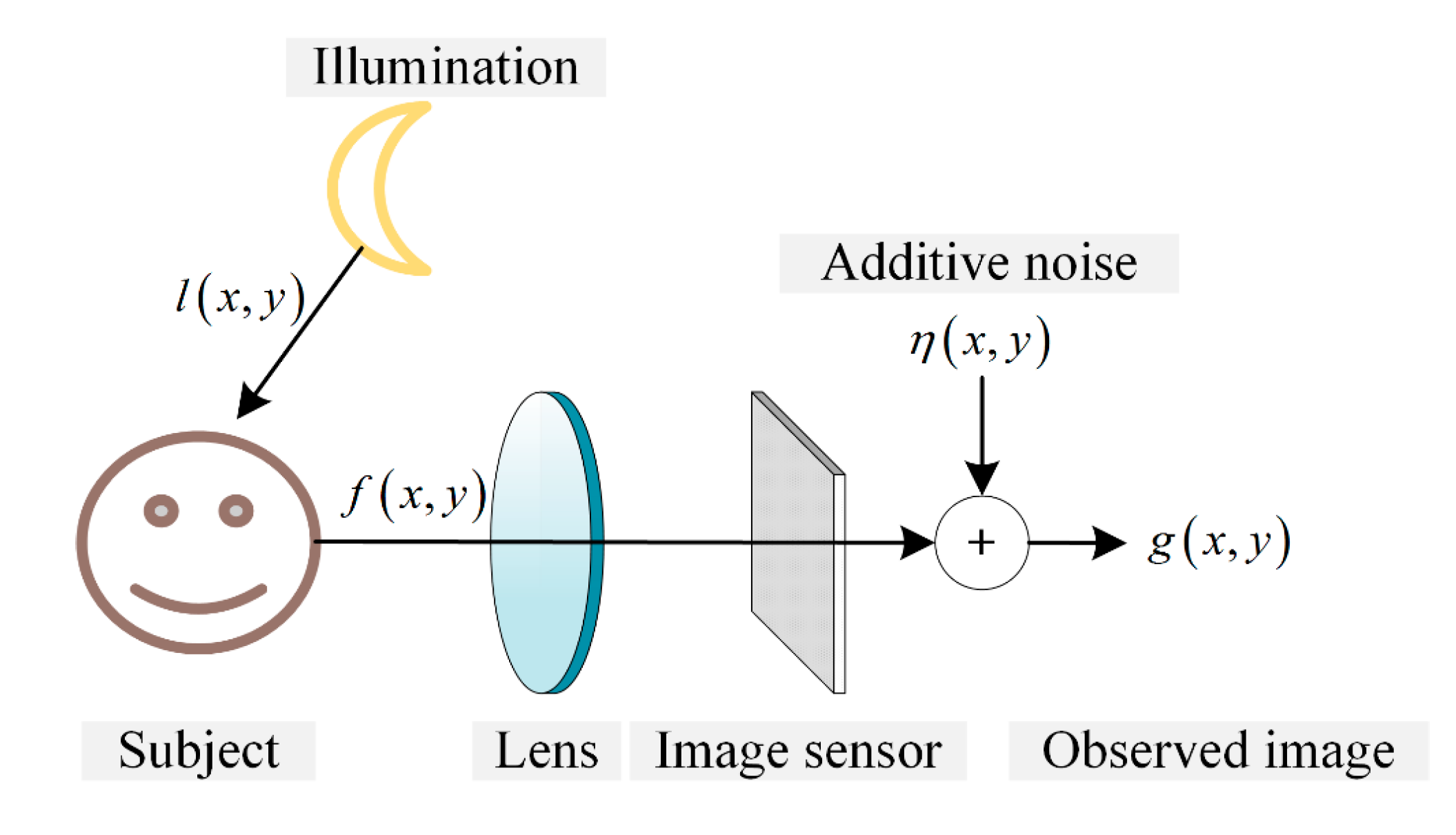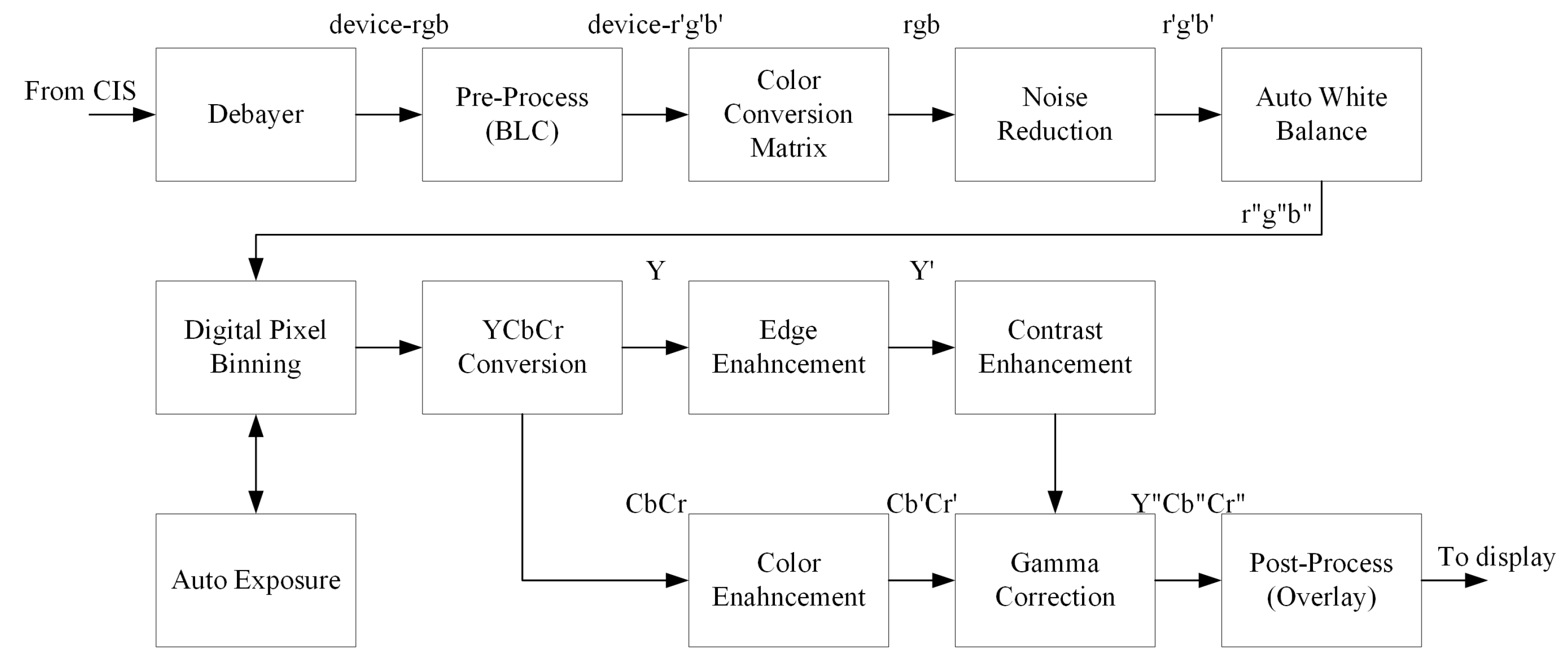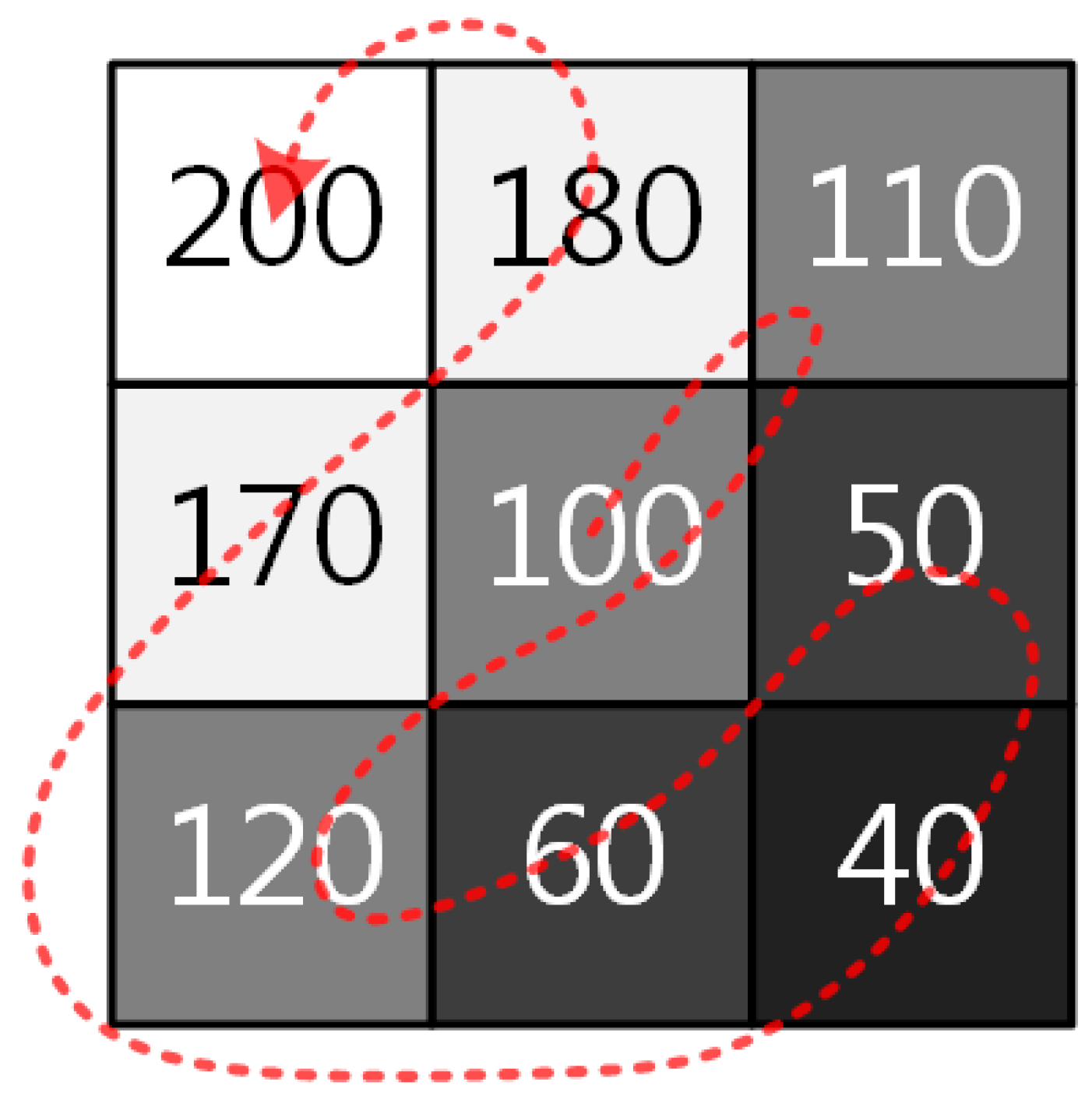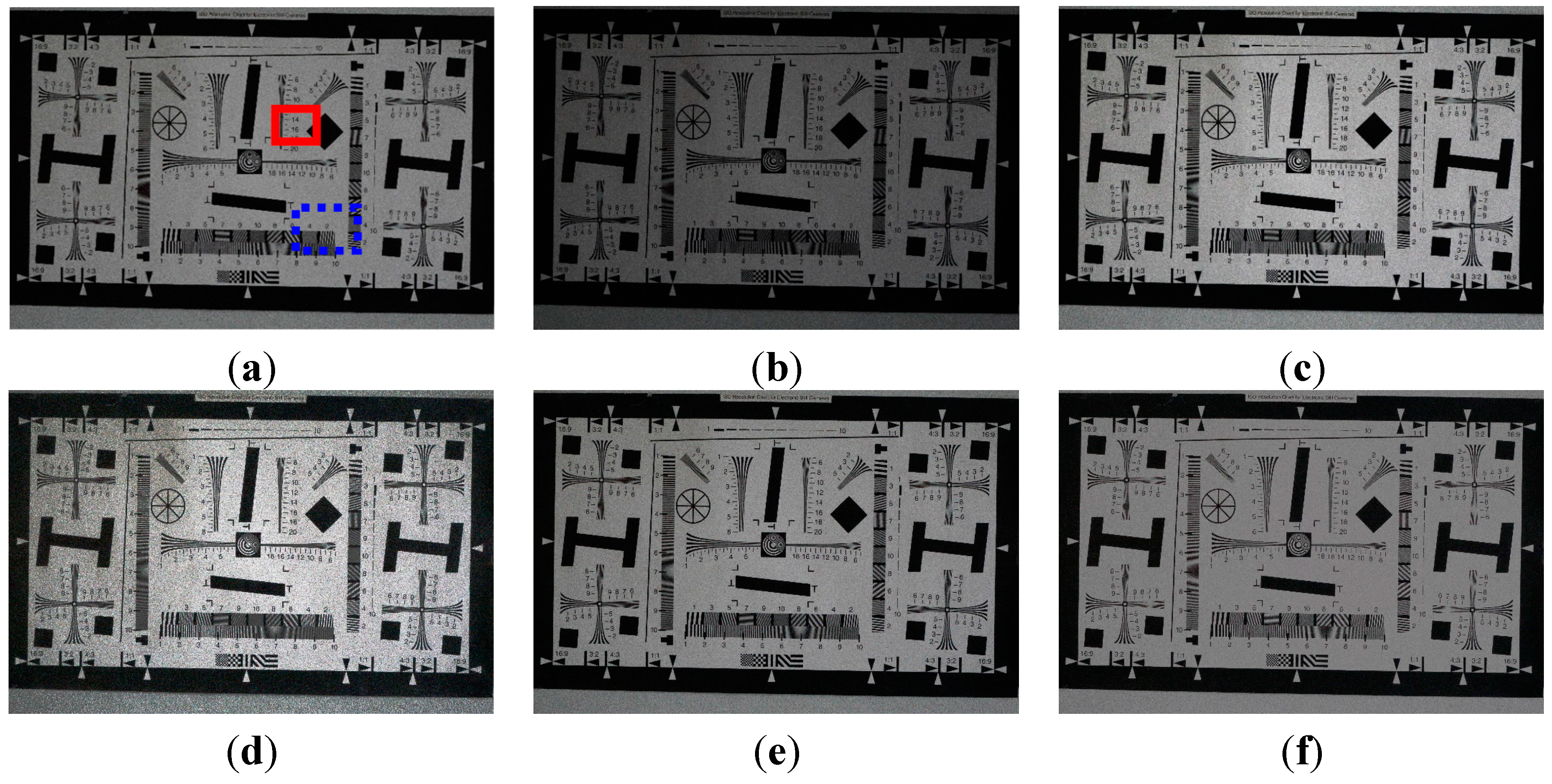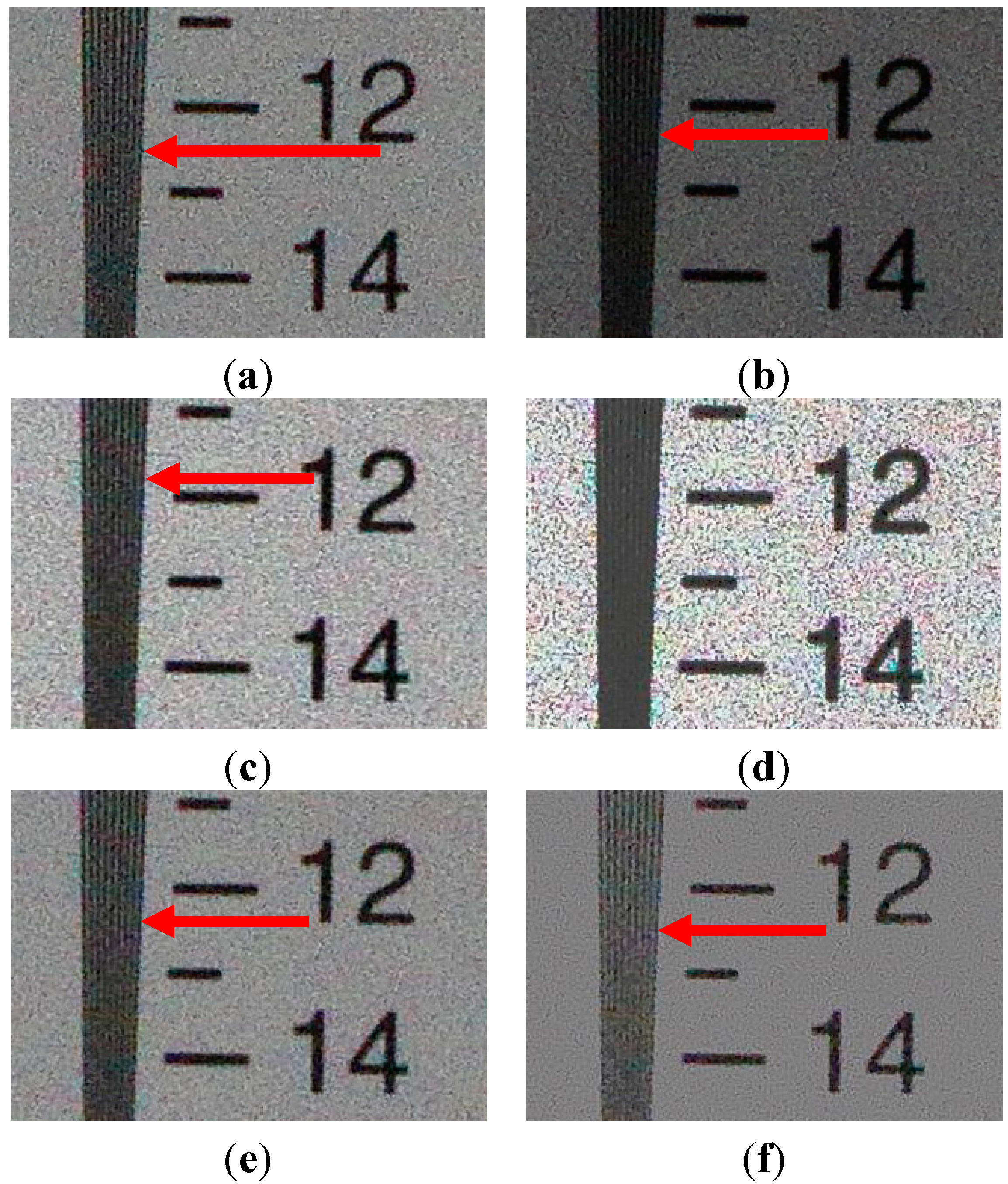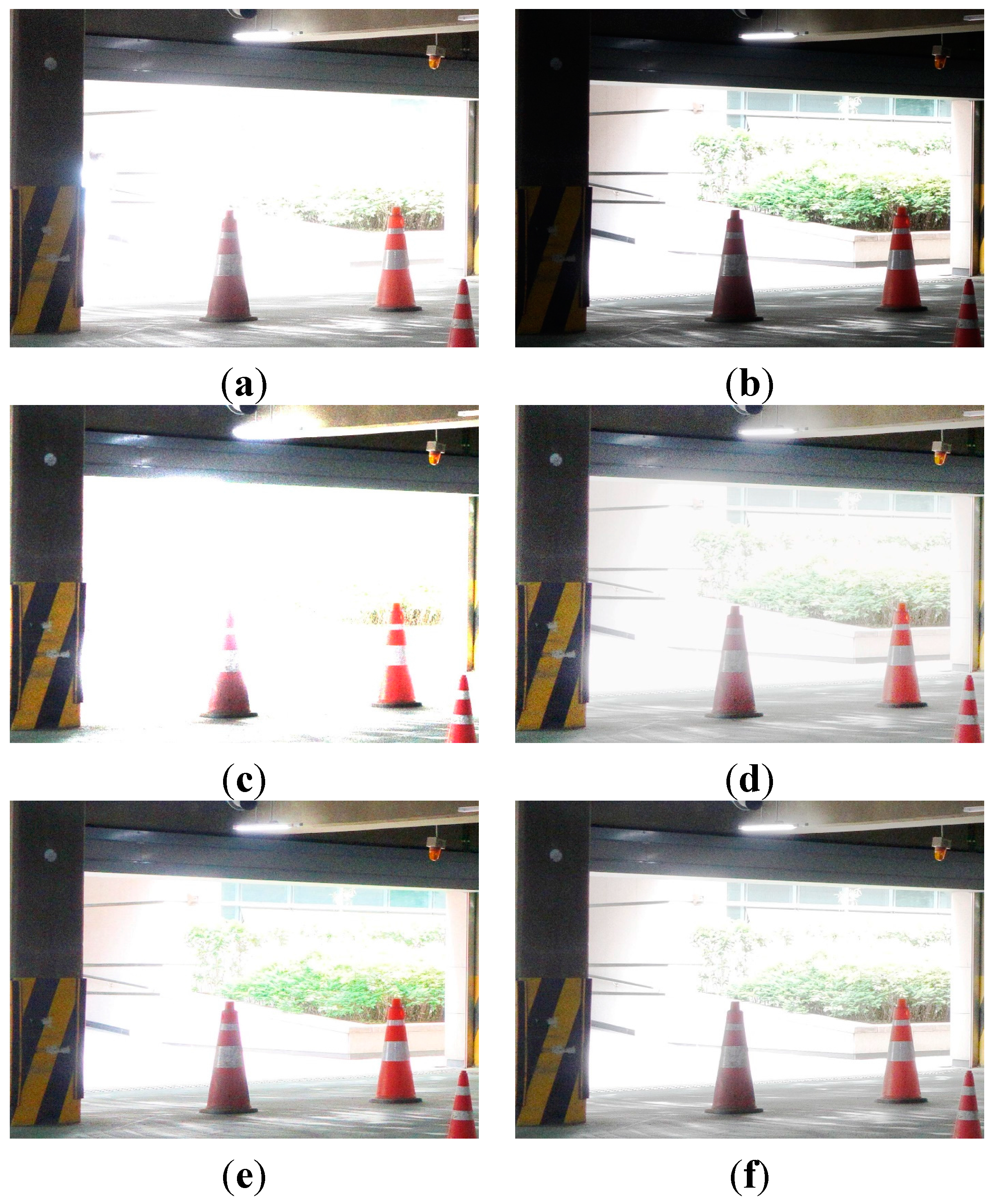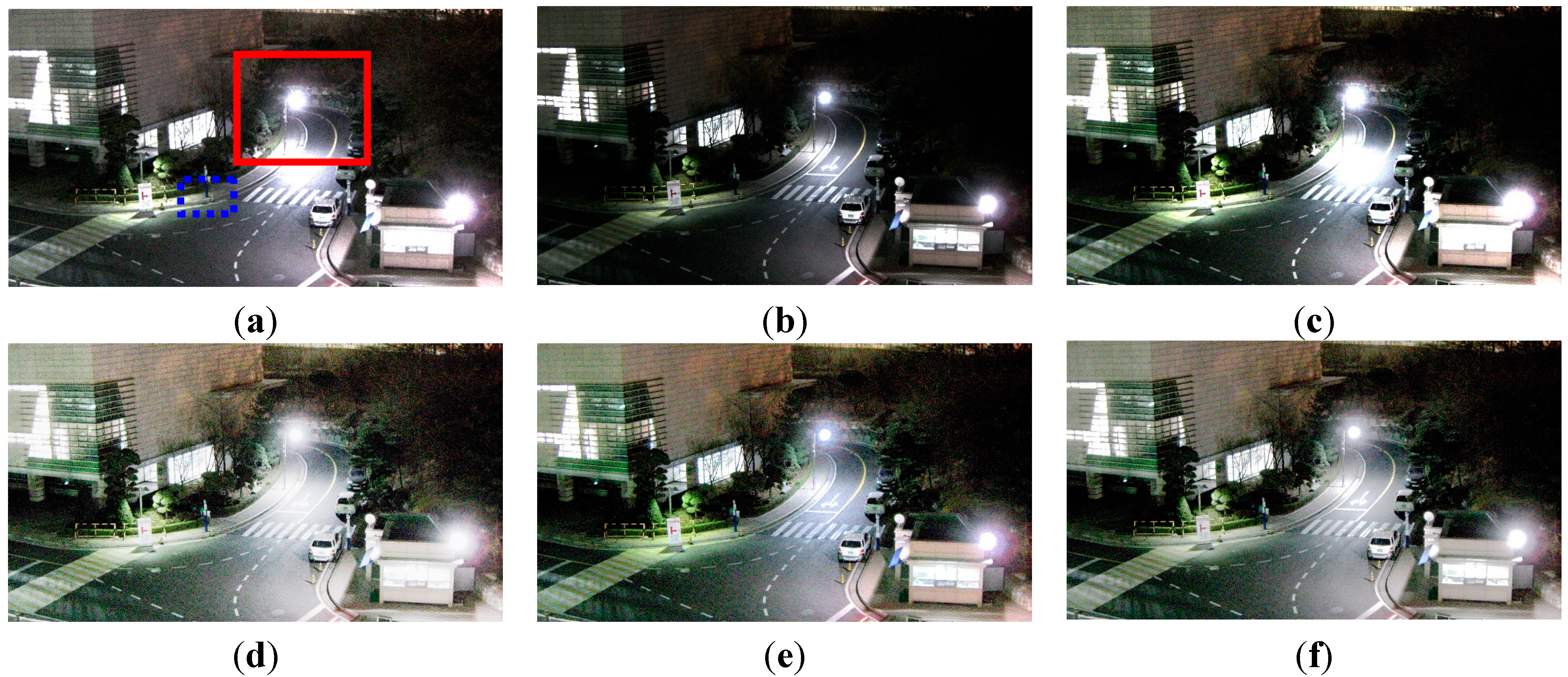2. Theoretical Background
Sensor-based pixel binning is designed to increase the sensitivity of an image sensor by combining multiple photodiodes into one bin at the cost of decreasing the spatial resolution as shown in
Figure 1a. On the other hand, digital pixel binning can accumulate multiple pixel values without losing the spatial resolution as shown in
Figure 1b.
Figure 1.
Two different pixel binning approaches to combine 2 × 2 pixels into one bin: (a) sensor-based pixel binning; and (b) digital pixel binning.
Figure 1.
Two different pixel binning approaches to combine 2 × 2 pixels into one bin: (a) sensor-based pixel binning; and (b) digital pixel binning.
Since the sensor-based pixel binning method does not reuse combined pixels as shown in
Figure 1a, it decreases the spatial resolution inversely proportional to the bin size. On the other hand, the digital pixel binning method reuses pixels used for adjacent bins as shown in
Figure 1b. The result of digital pixel binning can be considered a low-pass filtered version of the input image whose intensities are multiplied by the bin size. For this reason, spatial resolution is preserved in the pixel binning process while the details are smoothed by low-pass filtering.
2.1. Image Degradation Model for Low-Light Image Acquisition
The proposed image degradation model under low-light conditions is shown in
Figure 2, where
and
represent the luminance of the low-light environment and the reflected luminance by the subject, respectively.
Figure 2.
Image degradation model with an image sensor under low-light conditions.
Figure 2.
Image degradation model with an image sensor under low-light conditions.
The degraded image under low-light conditions can be expressed as:
Since
is a low-light version, a simple intensity amplification by factor α yields:
Although
has an amplified intensity, it results in intensity saturation because of the limited bit range, and also amplifies the sensor noise.
2.2. Digital Pixel Binning
The digital pixel binning process is expressed as:
where
represents the binning kernel, and * represents the convolution operation. For example, the kernel of 2 × 2 pixels binning plays a role of average filtering as:
where α = 4. Given a specific value of α, the result of pixel binning in Equation (3) is rewritten as:
where
. In
, the high frequency detail of the low-light degraded version, that is
, is suppressed by the average filtering, and then amplified by the ratio α. The distribution of random noise in
is concentrated toward zero by the average filtering, and will not be affected by the following amplification by the ratio α since most samples has become close to zero.
The digital pixel binning function in the conventional ISP for surveillance is shown as
Figure 3.
Figure 3.
Block diagram of the ISP pipeline including the digital pixel binning function.
Figure 3.
Block diagram of the ISP pipeline including the digital pixel binning function.
Digital pixel binning amplifies the intensity value before auto exposure (AE). The rest of the ISP functions, including noise reduction and image enhancement, can be used together with digital binning.
The digital pixel binning algorithm can be easily implemented using additional line memories. However, simple digital pixel binning algorithm results in image degradation as given in Equation (5). The proposed binning algorithm has been devised to avoid image degradation and additional hardware.
3. Adaptive Digital Pixel Binning
Although digital pixel binning can produce a brighter image without noise amplification in low-light conditions, the resolution of the resulting image decreases because of the low-pass filtering nature of the binning kernel. Furthermore, the intensity of the bright region is saturated when the pixel binning uses a fixed ratio. To solve these problems, the proposed algorithm performs the binning process in an adaptive manner according to the brightness, context, noise, and anti-saturation.
Figure 4 shows the block diagram of the proposed adaptive digital pixel binning algorithm.
Figure 4.
The proposed adaptive digital pixel binning algorithm.
Figure 4.
The proposed adaptive digital pixel binning algorithm.
3.1. Brightness Adaptive Binning Ratio
The ordinary digital pixel binning method amplifies the brightness of entire image using a fixed amplification ratio. For this reason, the dark region of image is enhanced to be brighter, while the bright region becomes saturated. To solve the saturation problem of conventional digital binning algorithms, the proposed algorithm changes the amplification ratio according to the brightness of the neighboring region in a spatially adaptive manner. The optimal amplification ratio at each pixel using the converted gray channel and the 3 × 3 average filter to suppress noise can be determined as follows:
where
represents the 3 × 3 average filter,
the converted gray cannel image, and
the operation that selects the maximum value in the argument. As a result,
has the value in
, and the order of relative brightness is preserved. The optimal binning ratio is defined using
as:
where
represents the maximum binning ratio.
takes the value 1 or higher. If
becomes close to 0,
approaches to its maximum value
. For example, if
is set to 4, the proposed algorithm uses the maximum of four pixels.
3.2. Context-Adaptive Binning
The pixel averaging process in the binning algorithm decreases the resolution of the resulting image. To minimize such degradation, the proposed algorithm uses weighted summation based on the relationship between the pixel and its neighbor. At the pixel position
, a
window generates the sorted difference vector
as:
where
represents the integer part of
, and
represents the vector whose elements are rearranged in the ascending order of the absolute value such that
Based on the definition in Equation (8),
is always equal to zero. Each element can have either a positive or negative value, whereas the absolute values are used for only sorting. The sorted vector of the
window based on the absolute difference from the center pixel is defined as:
The result of the context-adaptive binning is obtained from the weighted sum of similar pixels in the sorted vector as:
where the weighting vector
is defined using the optimal binning ratio given in Equation (7) as:
The pixel order q represents the labeling of each sorted pixel in the
window.
For example, a
window is shown in
Figure 5, where
and
. The corresponding
and
are respectively computed as:
and
If
, and
, the sorted ratio values are determined as
, and
. The binning result is then finally given as:
The kernel of the adaptive binning is expressed in matrix form as:
Since three pixel values 110, 100, 120 in the diagonal edge are similar as shown in
Figure 5, only summation of the three pixels can preserve the edge without being mixed with uncorrelated pixels, and the fourth similar pixel value, that is 60, is combined with smaller weight than the first three.
Figure 5.
An example of a
window with at the center.
Figure 5.
An example of a
window with at the center.
The ordinary digital pixel binning sums up pixel values in the pre-defined binning kernel throughout the input image. For this reason, details of the image cannot be preserved. On the other hand, the proposed algorithm can flexibly change the binning kernel based on the correlation of neighboring pixels. As a result, it is possible to minimize the degradation of edge details in the input image.
3.3. Noise-Adaptive Pixel Binning
Although the proposed context adaptive pixel binning can preserve the details in the image, it cannot suppress noise if the current pixel contains a noisy component. For this reason, uniform binning is effective in a noisy region as:
where
represents the uniform pixel binning coefficient vector whose elements are defined as:
The unity value of
q implies the current pixel whose position coefficient is equal to 1. However, coefficients of other pixels are determined by the number of total pixels to reduce the noise effect. If
, the uniform binning kernel is expressed in matrix form as:
The low-pass filtering performance of this kernel is higher than ordinary four-pixel digital pixel binning because its kernel has greater support. The result of the proposed binning is computed as:
where
represents the mean value of the local window, and λ a constant for the sensitivity of noise suppression. In this work,
was used for empirically best result.
3.4. Image Blending for Anti-Saturation
Although the brightness-adaptive procedure adjusts the binning ratio, the binning algorithm itself simply amplifies the brightness and results in saturation in the processed image. In order to prevent saturation, the proposed algorithm combines the input low-light and the binning result given in Equation (19) using the image blending method.
The blending image is computed by combining the amplified image
and the input
as:
where the blending weighted coefficient is defined as:
In Equation (9), μ represents the maximum bit depth of the image for normalization. If the maximum binning ratio increases,
becomes smaller because
is divided by
. For this reason, the saturated value is substituted by the lower one. If
increases,
becomes closer to
, which is the input image in low-light environments. On the other hand, if
decreases, the corresponding region becomes darker. In this case,
takes the data from the amplified image
. As a result,
is the image of suppressed noise and saturation.
4. Experimental Results
Three test images were acquired using two different types of camera for the experiment. A digital camera with a 20 megapixel CMOS image sensor was used to acquire two groups of test images: (1) a resolution chart; and (2) a parking garage. A commercial surveillance camera with a full high-definition (1920 × 1080) CMOS image sensor was also used to capture the outdoor scene. In order to obtain images with different exposure values (EVs), multiple ISO values were used with a fixed aperture and shutter speed. For evaluation of the performance of noise suppression, entropy and variance values are computed in a flat region of images. In order to acquire input test images, auto white balance (AWB) and AE parameters are fixed, and edge enhancement and color suppression functions are bypassed. In order to evaluate the independent performance of digital pixel binning, noise reduction functions were turned off, and only gamma correction is applied as shown in
Figure 3.
In order to evaluate the performance of brightness enhancement, the proposed algorithm is compared with ordinary digital pixel binning, Kim’s clipped histogram equalization [
8], and Jiang’s image enhancement [
9]. Each amplification ratio of image enhancement algorithms was set to preserve the same brightness as the reference value. However, the average brightness of output images is not exactly the same because of the different properties of each amplification algorithm.
Figure 6.
Enhancement results using the ISO 12233 resolution chart image: (a) The reference image with ISO 3200 (EV = 0); (b) one-step lower exposure image using ISO 1600 (EV = −1); (c) enhanced image of (b) using the ordinary two-pixel digital pixel binning; (d) enhanced image of (b) using Kim’s algorithm; (e) enhanced image of (b) using Jiang’s algorithm; and (f) enhanced image of (b) using the adaptive four-pixel digital pixel binning.
Figure 6.
Enhancement results using the ISO 12233 resolution chart image: (a) The reference image with ISO 3200 (EV = 0); (b) one-step lower exposure image using ISO 1600 (EV = −1); (c) enhanced image of (b) using the ordinary two-pixel digital pixel binning; (d) enhanced image of (b) using Kim’s algorithm; (e) enhanced image of (b) using Jiang’s algorithm; and (f) enhanced image of (b) using the adaptive four-pixel digital pixel binning.
Figure 6 shows the experimental results of enhancing the ISO 12233 resolution chart image under 15 lux illumination. Three test images are acquired using different ISO values including 3200 and 1600, fixed aperture size F11, and shutter speed 1/16 s.
Figure 6a,b respectively show the normal and one-step lower exposure images.
Figure 6c shows the enhanced image of
Figure 6b using the ordinary digital pixel binning with
horizontal kernel, such as
.
Figure 6d,e show enhanced images of
Figure 6b using Kim’s and Jiang’s algorithms, respectively.
Figure 6f shows the enhanced image of
Figure 6b using the proposed algorithm with a maximum binning ratio of 4. For clearer visual comparison, the magnified region of the red box in
Figure 6 is shown in
Figure 7.
Figure 7.
The magnified version of the red box in
Figure 6a: (
a) The reference image with ISO 3200 (EV = 0); (
b) one-step lower exposure image using ISO 1600 (EV = −1); (
c) enhanced image of (
b) using ordinary two-pixel digital pixel binning; (
d) enhanced image of (
b) using Kim’s algorithm; (
e) enhanced image of (
b) using Jiang’s algorithm; and (
f) enhanced image of (
c) using adaptive eight-pixel digital pixel binning.
Figure 7.
The magnified version of the red box in
Figure 6a: (
a) The reference image with ISO 3200 (EV = 0); (
b) one-step lower exposure image using ISO 1600 (EV = −1); (
c) enhanced image of (
b) using ordinary two-pixel digital pixel binning; (
d) enhanced image of (
b) using Kim’s algorithm; (
e) enhanced image of (
b) using Jiang’s algorithm; and (
f) enhanced image of (
c) using adaptive eight-pixel digital pixel binning.
The red arrows in
Figure 7 indicate the position where lines can be just resolved with the differential intensity value over 20.
Figure 7d is so severely distorted that it is not possible to find a position that has difference of 20 or larger. As shown in
Figure 7d–f, the proposed binning algorithm can better preserve vertical edges and suppress noise than existing ordinary image enhancement algorithms.
For evaluating the performance of noise suppression,
Table 1 summarizes the entropy [
10] and variance values of a 400 × 400 flat region in the blue dotted box in
Figure 6a. The mean value represents the average luminance of the image, and variance the average value of squared difference between the pixel intensity and the corresponding local mean. As shown in
Table 1, the higher the ISO value, the more noise in the acquired image. As shown in
Table 1 both ordinary binning and Kim’s algorithms (c and d) significantly amplify the noise. On the other hand, the proposed algorithm (f) gives lower entropy and variance values. Although Jiang’s algorithm has a noise filtering function, the noise suppression performance is lower than the proposed algorithm. Noise-adaptive uniform pixel binning can also better suppress noise than ordinary digital pixel binning.
Table 1.
Mean, entropy, and variance values of six images in
Figure 6.
Table 1.
Mean, entropy, and variance values of six images in Figure 6.
| | Mean | Entropy | Variance |
|---|
| (a) | 87.4027 | 5.658747247 | 49.18756931 |
| (b) | 58.8574 | 5.404929441 | 40.20226864 |
| (c) | 101.7330 | 6.214999006 | 69.25368623 |
| (d) | 113.9225 | 6.995119196 | 117.132437 |
| (e) | 87.57096 | 5.574787129 | 46.6319541 |
| (f) | 91.3899 | 4.926924468 | 24.62198825 |
Figure 8 shows the experimental results of enhancing a typical low-light image acquired under low illumination of under 8 lux. Two input test images are acquired using different ISO values of 3200 and 800, and fixed aperture size F5.6 and shutter speed 1/15 s.
Figure 8.
Experimental results using the parking garage image: (a) The reference image with ISO 3200 (EV = +1); (b) one-step lower image using ISO 800 (EV = −1); (c) enhanced image of (b) using ordinary four-pixel digital pixel binning; (d) enhanced image of (b) using Kim’s algorithm; (e) enhanced image of (b) using Jiang’s algorithm; and (f) enhanced image of (b) using the adaptive four-pixel digital pixel binning algorithm.
Figure 8.
Experimental results using the parking garage image: (a) The reference image with ISO 3200 (EV = +1); (b) one-step lower image using ISO 800 (EV = −1); (c) enhanced image of (b) using ordinary four-pixel digital pixel binning; (d) enhanced image of (b) using Kim’s algorithm; (e) enhanced image of (b) using Jiang’s algorithm; and (f) enhanced image of (b) using the adaptive four-pixel digital pixel binning algorithm.
Figure 8a,b shows one-step upper and one-step lower exposure images.
Figure 8c shows the brightness-enhanced image of
Figure 8b using ordinary digital pixel binning with the 2 × 2 binning kernel.
Figure 8c,d show brightness-enhanced images of
Figure 8b using Kim’s and Jiang’s algorithms, respectively.
Figure 8f shows the brightness-enhanced image of
Figure 8b using the proposed algorithm with the maximum binning ratio of 4. For clearer visual comparison, the magnified version of
Figure 8 is shown in
Figure 9.
Figure 9.
The magnified version of the red box shown in
Figure 8a: (
a) The reference image with ISO 3200 (EV = +1); (
b) one-step lower exposure image using ISO 800 (EV = −1); (
c) enhanced image of (b) using ordinary 2 × 2 digital pixel binning; (
d) enhanced image of (b) using Kim’s algorithm; (
e) enhanced image of (b) using Jiang’s algorithm; and (
f) enhanced image of (b) using the adaptive 2 × 2 digital pixel binning algorithm.
Figure 9.
The magnified version of the red box shown in
Figure 8a: (
a) The reference image with ISO 3200 (EV = +1); (
b) one-step lower exposure image using ISO 800 (EV = −1); (
c) enhanced image of (b) using ordinary 2 × 2 digital pixel binning; (
d) enhanced image of (b) using Kim’s algorithm; (
e) enhanced image of (b) using Jiang’s algorithm; and (
f) enhanced image of (b) using the adaptive 2 × 2 digital pixel binning algorithm.
As shown in
Figure 9, the proposed binning algorithm can better preserve details in the saturated region than ordinary algorithms.
Table 2.
Mean, entropy, and variance values of four images in
Figure 8.
Table 2.
Mean, entropy, and variance values of four images in Figure 8.
| | Mean | Entropy | Variance |
|---|
| (a) | 80.8791 | 5.643978317 | 49.27466869 |
| (b) | 51.1724 | 3.96713916 | 6.93515173 |
| (c) | 107.4580 | 5.666662266 | 51.28301441 |
| (d) | 97.76097 | 6.146823904 | 66.20613885 |
| (e) | 86.25345 | 5.377880622 | 40.39314018 |
| (f) | 88.7303 | 5.251893518 | 37.16049859 |
To evaluate the performance of noise suppression,
Table 2 summarizes the entropy and variance values of a 400 × 400 flat region in the blue dotted box in
Figure 8a. As shown by the experimental results in
Table 2, the higher the ISO value, the more noise in the acquired image. As shown in
Table 2, existing enhancement algorithms (c–e) cannot avoid noise amplification. On the other hand, the proposed algorithm (f) produces lower entropy and variance values.
Figure 10 shows the experimental results of enhancing a typical low-light image acquired by a survaillence camera under low illumination of 3 lux. Two input test images are acquired using different analog front end (AFE) gain of 12 dB and 18 dB, fixed aperture size F1.4, and shutter speed 1/30 s.
Figure 10.
Experimental results using the outdoor image: (a) The reference image with 18 dB gain; (b) underexposed image with 12 dB gain; (c) enhanced image of (b) using ordinary two-pixel digital pixel binning; (d) enhanced image of (b) using Kim’s algorithm; (e) enhanced image of (b) using Jiang’s algorithm; and (f) enhanced image of (b) using the adaptive four-pixel digital pixel binning algorithm.
Figure 10.
Experimental results using the outdoor image: (a) The reference image with 18 dB gain; (b) underexposed image with 12 dB gain; (c) enhanced image of (b) using ordinary two-pixel digital pixel binning; (d) enhanced image of (b) using Kim’s algorithm; (e) enhanced image of (b) using Jiang’s algorithm; and (f) enhanced image of (b) using the adaptive four-pixel digital pixel binning algorithm.
Figure 10a,b respectively show 18 dB and 12 dB AFE gain images.
Figure 10c shows the brightness-enhanced image of
Figure 10b using the ordinary digital pixel binning with the
horizontal binning kernel.
Figure 10c,d show brightness enhanced images of
Figure 10b using Kim’s and Jiang’s algorithms, respectively.
Figure 10f shows the brightness-enhanced image of
Figure 10b using the proposed algorithm with a maximum binning ratio of 4. For clearer visual comparison, the magnified versions of
Figure 10 are shown in
Figure 11.
As shown in
Figure 10, the proposed binning algorithm can better preserve details in the saturated region than the ordinary algorithms.
To evaluate noise suppression performance,
Table 3 summarizes the entropy and variance values of a 100 × 100 flat region in the blue dotted box in
Figure 10a. As shown in
Table 3, the higher the AFE gain, the more noise in the acquired image. As shown in
Table 3, existing enhancement algorithms (c–e) cannot avoid noise amplification. On the other hand, the proposed algorithm (f) gives lower entropy and variance values.
Figure 11.
The magnified version of the red box shown in
Figure 10a: (
a) The reference image with 18 dB gain; (
b) underexposed image with 12 dB gain; (
c) enhanced image of (b) using ordinary two-pixel digital pixel binning, (
d) enhanced image of (b) using Kim’s algorithm; (
e) enhanced image of (b) using Jiang’s algorithm; and (
f) enhanced image of (b) using the adaptive four-pixel digital pixel binning algorithm.
Figure 11.
The magnified version of the red box shown in
Figure 10a: (
a) The reference image with 18 dB gain; (
b) underexposed image with 12 dB gain; (
c) enhanced image of (b) using ordinary two-pixel digital pixel binning, (
d) enhanced image of (b) using Kim’s algorithm; (
e) enhanced image of (b) using Jiang’s algorithm; and (
f) enhanced image of (b) using the adaptive four-pixel digital pixel binning algorithm.
Table 3.
Mean, entropy, and variance values of four images in
Figure 10.
Table 3.
Mean, entropy, and variance values of four images in Figure 10.
| | Mean | Entropy | Variance |
|---|
| (a) | 85.99876 | 6.275580147 | 72.95065843 |
| (b) | 44.42691 | 5.547833288 | 47.37427703 |
| (c) | 76.56178 | 6.389223771 | 78.242229651 |
| (d) | 112.9766 | 6.012225161 | 74.25892886 |
| (e) | 89.08364 | 6.083478838 | 71.54243048 |
| (f) | 88.74255 | 5.839596986 | 62.86275855 |
5. Conclusions
This paper proposed an adaptive digital pixel binning algorithm in terms of brightness, context, noise, and anti-saturation. In order to solve the noise amplification problem encountered with ordinary brightness amplification methods, the proposed algorithm performs digital pixel binning in an adaptive manner in various aspects. As shown in the experiment, noise-adaptive uniform pixel binning can better suppress noise than the ordinary enhancement methods. Moreover, incorporation of context-adaptive pixel binning can successfully preserve the resolution of high-frequency details in an image.
The proposed algorithm consists of simple, fundamental arithmetic operations and sorting. The computational complexity depends on the sorting algorithm, which dominates the computational complexity of the entire algorithm. When using the general sorting algorithm, the complexity is , where
represents the number of pixels in the window. Since the proposed algorithm neither requires a frame-memory nor an iterative computation, it is suitable to be embedded in a general image signal processor. Since the proposed algorithm does not affect existing noise reduction or contrast enhancement algorithms, it is very efficient to implement the algorithm along with ISP functions. Future work will combine existing noise reduction algorithms by sharing the hardware to reduce computational complexity.

